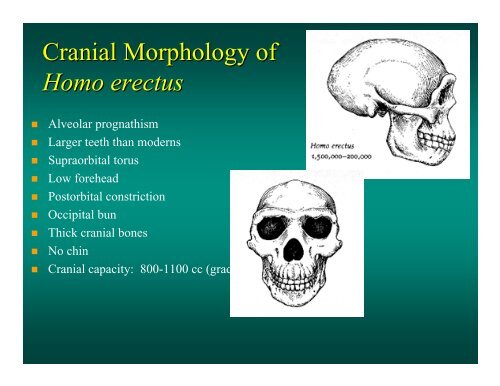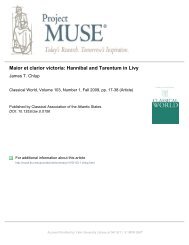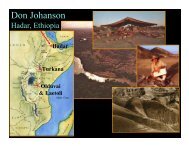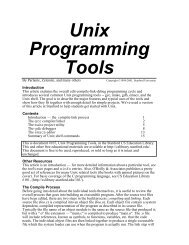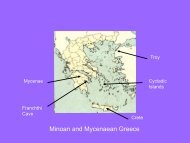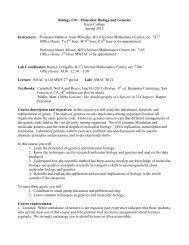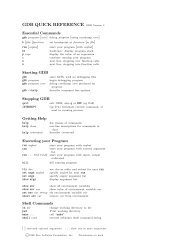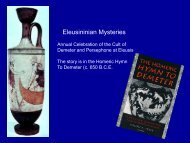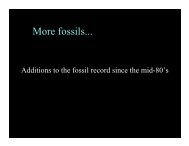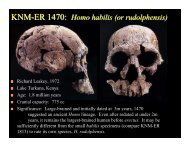Cranial Morphology of Homo erectus
Cranial Morphology of Homo erectus
Cranial Morphology of Homo erectus
- No tags were found...
Create successful ePaper yourself
Turn your PDF publications into a flip-book with our unique Google optimized e-Paper software.
If I Only Had a Brain . . .What does it take?
Staying coolPROBLEM:• Most mammals cannotremain active in tropical daytime• Brain cooling presents extra challengeSOLUTIONS:• Global cooling at time <strong>of</strong> <strong>Homo</strong> emergence• Triple benefit <strong>of</strong> bipedal posture• Sweat on hairless body 250 times more effective• Altered arrangement <strong>of</strong> blood vessels cooling brain
Energy needs <strong>of</strong>an expanding brain• 20% energy for 2%<strong>of</strong> body mass• Gut vs. brain– Both expensive– Mutually exclusive• Reducing gut size– Depends on diet• Meat?
Meat and the Brain• <strong>Homo</strong> brain grows atfetal rate after birth• Energetics <strong>of</strong> nursing– Baby higher on foodchain– 10:1 efficiency drop• Maternal nutrition• Significance <strong>of</strong> meat
Alternative Hypothesis: Tubers• Abundant• Digging sticks• Nutritious if cooked• Social structure?
Did Australopithecus eat meat?• Stable isotope analysis <strong>of</strong> South Africanafricanus fossils indicate C4 plants– Meat from grazing animals?• A. garhi from Ethiopia: tools and cut bones
KNM-ER 1808<strong>Homo</strong> <strong>erectus</strong>/ergaster• Leakey team, 1974• East Lake Turkana, Kenya• Age: 1.7 million years1808tibiaPartial female skeleton displayspathological bone buildup,suggesting hypervitaminosisfrom eating carnivore liver.She must have been cared forduring her long terminal illness.Normal<strong>erectus</strong>
Hunters orScavengers?• Many species do both• What kind <strong>of</strong> scavenging?– Marginal scrounging?– Power scavenging?
Hunters or Scavengers?• Many species do both• What kind <strong>of</strong> scavenging?– Marginal scrounging?– Power scavenging?– Blumenschine’s nonconfrontationalscavenging• Louis Leakey– Experiments in low-techhunting– Traps and snares• “Mighty hunters” oropportunists?– rudolphensis and early<strong>erectus</strong> likely opportunists– Later <strong>erectus</strong> a “mighty”hunter?
Torralba and AmbronaLate <strong>Homo</strong> <strong>erectus</strong>400,000 years ago
The Great Life-History Shift• Life History: Gestation, birth, weaning, developmentalpatterns, sexual career, life span, etc.• Leakey: major shift in <strong>Homo</strong>• Evidence: Dental growth rates, pelvic and skull measurements• Australopithecus had short, chimplike childhood• <strong>Homo</strong> pattern:– Slow body growth, fast brain growth– Adolescent growth spurtBrain growth from birth to adulthood:Ape2xAustralopithecus 2.6x<strong>Homo</strong> <strong>erectus</strong> 3.3x<strong>Homo</strong> sapiens 3.5x
KNM-WT 15000Nariokotome or “Turkana boy”<strong>Homo</strong> <strong>erectus</strong>/ergaster• Kamoya Kimeu, Leakey team,1984• West Lake Turkana, Kenya• Age: 1.6 million years• <strong>Cranial</strong> capacity: 880 ccThe Turkana boy is the most complete<strong>of</strong> any early skeleton, and it hasenabled scientists to learn muchabout <strong>Homo</strong> <strong>erectus</strong>/ergaster. Itdied in early adolescence but wouldhave reached a height <strong>of</strong> more than6’ at maturity, with a cranialcapacity <strong>of</strong> 909 cc.
Turkana Boy vs. . Lucy• Rib cage?• Body shape?• Pelvic shape?• Waist (gut)?• Tibia & ulna?
Size, proportions and dimorphism
Who talked?• Contours <strong>of</strong> skull, neck• Reconstructed Australopithecusvocal tract is apelike– Could not make human speech sounds– High larynx• Human larynx is low– Flexed basicranium• <strong>erectus</strong> was transitional• Turkana boy’s vertebra had smallspinal foramen– Limited ability to control muscles forspeech• proto-language?(more later . . .)
Fire and speech• Larynx descends in <strong>Homo</strong>, for speech• Susceptibility to choking• Meat is a common culprit• Meat is important for brain growth• Cooked meat easier to swallowViva Prometheus!
• Safety• Warmth• Hunting & technology• Altering environment• Extending daily activity• Social focusPromethean Fire
Home base, anyone?• Glynn Isaac vs. Lew Binford• Site 50, 1.5 mya?• Terra Amata, France 400 kya
Example: FLK-Zinj“living floor”• Olduvai Gorge, Mary Leakey• Zinj skull found there• Thousands <strong>of</strong> mammals bones– Open-country species– Cut marks & tooth marks• <strong>Homo</strong> tibia• Once near a lake• Oldowan tools• Manuports
Theories <strong>of</strong> Site Formation• Home base?• Animal activity?• Water action?• Routed foraging?• Picnic site?• Tool cache?• Kill site?• Scavenged carcass?• Palimpsest?
Conclusions:• Hominid Package (“Sharing and Carrying”hypothesis) provides framework for researchand debate• Criticisms and alternative theories• Still defended by some (Latimer, Lovejoy)• Problematic for Australopithecus• More probable for <strong>Homo</strong>, especially after 1 mya
Next…The transition to sapiens


